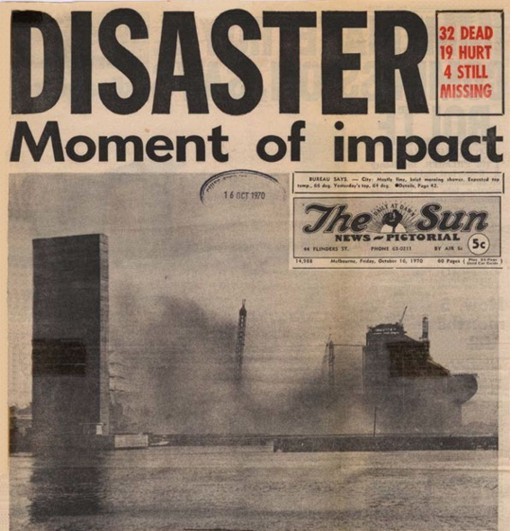The Story:
 At 11:50 a.m.
on 15 October 1970, a 112m span of the West Gate Bridge, known
as span 10–11, collapsed during construction. Approximately
2000 tonnes of steel and concrete came crashing down into the
muddy banks of the Yarra below, taking workers and their
machinery, tools, and sheds with them.
At 11:50 a.m.
on 15 October 1970, a 112m span of the West Gate Bridge, known
as span 10–11, collapsed during construction. Approximately
2000 tonnes of steel and concrete came crashing down into the
muddy banks of the Yarra below, taking workers and their
machinery, tools, and sheds with them.
When the two half girders on the west side, span 10–11, were
brought into close proximity up in the air it was established that
a camber difference of about 11cm existed between them. The
engineers proposed that the vertical difference of level could be
taken out by using kentledge (ballast) to push down the north half
span relative to its south counterpart. Ten cube-shaped concrete
blocks, each weighing about 8 tonnes, were on site from a previous
operation, and it was thought that these would give about the right
order of load to remove the camber difference.
The act of adding the kentledge was the precipitating cause of a
buckle that appeared on the inner upper panel around joint 4–5
north. The buckle was a clear indication that partial failure of
the structure had occurred.
Workers were given instructions to remove some bolts from the
northern half at mid-span to remove the buckle. After about sixteen
bolts had been loosened there was significant slipping of the two
plates relative to one another such that the loosened bolts were
jammed tightly in their holes and could not be easily removed.
Eventually about 30 bolts were removed from the box 5 side of the
splice, and about seven bolts from the box 4 side, all close to the
longitudinal centre line. The buckle spread right across one half
of the bridge. An hour later both halves of the span collapsed.
The whole 2,000-tonne mass plummeted into the Yarra mud with an
explosion of gas, dust, and mangled metal that shook buildings
hundreds of metres away. Homes were spattered with flying mud. The
roar of the impact, the explosion, and the fire that followed could
be heard more than three kilometres away.
Thirty-five workers lost their lives that day; many others were
injured. Most victims were those working on top of the bridge at
the time of the collapse. Some men were lucky enough to be on their
morning break away from the site; others simply ran out of the way
before the bridge fell on top of them.
An expert technical committee was immediately established to
investigate the scene. The following morning, amid nationwide grief
and horror, then Premier Sir Henry Bolte announced the
establishment of a Royal Commission, chaired by Mr Justice Barber,
to investigate the cause of the collapse. Its report, tabled in
parliament in 1971, left no party associated with the collapse
blameless and stated that:
"Error begat error . . . and the events which led to
the disaster moved with the inevitability of a Greek
Tragedy."
If the above description was whetted your appetite, take a look at
the following two web sites for more details of the disaster:
West Gate
Bridge Memorial
Disaster
at West Gate
The first-listed site is the better one, and has a full
description of the lead-up to the collapse, the collapse, and the
aftermath.
The sections of the bridge at the cache location were tested by
Monash laboratories as part of the investigation into the cause of
the collapse. Do yourself a favour and read the information boards
on site. There isn't much to read, and it will enhance your
enjoyment of the cache. The next time you drive over the West Gate
Bridge, spare a thought for the men who went to work on 15 October
1970, but didn't return home that night.
The Challenge:
The difficulty rating of 2½ stars above just represents the
median of the possible difficulty ratings. The challenge of this
cache is retrieving it unobserved. Just how difficult this will be,
will depend on the day you choose, and the time of that day. It
will be exceedingly difficult, if not impossible, to retrieve and
replace this cache at around lunchtime on a university day. The
cache was placed on a weekend during the term break. The following
table gives you a guide to the difficulty level for this cache:
 |
Weekend during term break. |
 |
Week day during term break. |
 |
After hours during term. |
 |
Class hours during term. |
 |
Lunch time during term. (Forget it!) |
Finding the cache is relatively easy; retrieving it might be a
different matter. Please be careful!
Stealth will be required at most
times! If there are people about, give it a miss, and
come back later. Also, be aware that there are many windows
overlooking the cache site. You may be observed!
The Cache:
The cache container is a 2L Sistema clip-top box.
The initial contents are:
Emu
Quartz car clock
Stress ball/juggling ball
Builder's tape measure
Puddy cat
Bag of marbles
Yellow highlighter
Koala lapel clip
Magnetic key holder (might make a useful micro cache)
Tiger Balm Plus
Mini back pack/camera case
Log book, stash note, and pen
As always, please replace the cache exactly where you found it
to discourage accidental discovery.